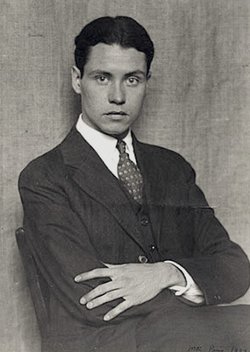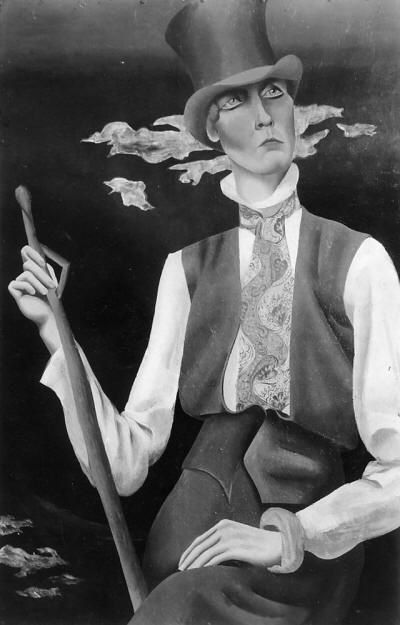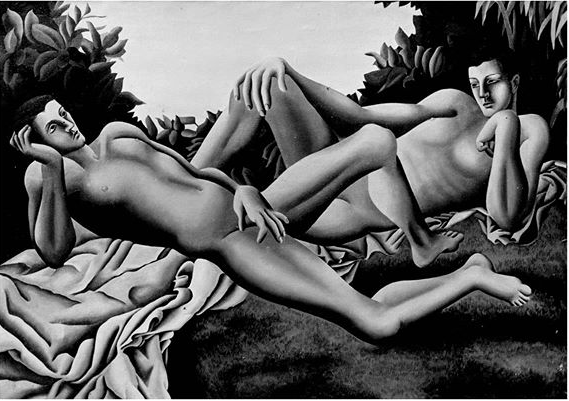

Partner Virgil Thomson, René Crevel
Queer Places:
5 Rue Campagne Première, 75014 Paris, France
1 Villa Seurat, 75014 Paris, France
Le Boeuf sur le Toit (The Ox on the Roof), 28 Rue Boissy d'Anglas, 75008 Paris
 William Eugene McCown (July 27, 1898 - April 23, 1966), better known as Eugene McCown (aka MacCown) among his friends, was a multi-talented artist and world traveler. “Gertrude [Stein] used to wonder and I still do why Eugene doesn’t write his memoirs which would be so much better
than all those books by bright young men about Paris whose authors didn't really know anybody and Eugene knew
everybody and had so many more stories to tell which were all unbelievable and all perfectly true.”
Alice B. Toklas about Eugene McCown, 1948.
William Eugene McCown (July 27, 1898 - April 23, 1966), better known as Eugene McCown (aka MacCown) among his friends, was a multi-talented artist and world traveler. “Gertrude [Stein] used to wonder and I still do why Eugene doesn’t write his memoirs which would be so much better
than all those books by bright young men about Paris whose authors didn't really know anybody and Eugene knew
everybody and had so many more stories to tell which were all unbelievable and all perfectly true.”
Alice B. Toklas about Eugene McCown, 1948.
McCown was gay and spent many years "out" in Paris, France during the 1920s where he was "notoriously narcissistic and promiscuous". Back in Paris in the spring of 1926, Klaus Mann met René Crevel, a committed internationalist for perverse reasons: "He spent his days with Americans, Germans, Russians, and Chinese, because his mother suspected all foreigners to be crooks or perverts". Sitting on Mann’s bed, Crevel read out the early chapters of his novel La Mort difficile, with their "venomous" portrait of his mother. On this trip, Mann also met Jean Cocteau ("The hours spent in his company assume in my recollection a savour both of burlesque show and magic ritual"), Eugene McCown, Pavel Tchelitchew, Julien Green, Jean Giraudoux and others.
William Eugene McCown was born in El Dorado Springs (Mo, Cedar county), the son of William Henry McCown (1870-1961)[3] and Inez Boyer (1877-1909).[4] In 1900, the family settled in Deepwater (Henry county) where McCown’s father ran a prominent hardware store. After his mother’s death, he moved with his sister Laurayne to his maternal uncle’s in Kansas City, where he would be given a formal education. He was taught how to sketch[5] and play the piano[6] with great success. At the Central High school of Kansas City, he met Virgil Thomson (the future composer and critic) who was to become a life-long friend.[7] When he had completed two years of journalism[8] at the University of Missouri, McCown went to New York to paint at the Art Students League and at Woodstock, where he studied with Andrew Dasburg and Eugene Speicher. For six months, in 1920, he traveled through the West Indies as a painter.[9] In May 1920, his first productions (landscapes and portraits) were exhibited Caracas.[10] On his return to New York, McCown mingled in the local artistic circles. His fearless temper and homosexuality as well as the rise of puritanism and Prohibition may explain why McCown worked his way to France on a freighter in 1921.



Nancy Cunard by Eugene McCown

Janet Flanner by Eugene McCown

La Siesta (c. 1925)
After a stay in Venezuela where, in Caracas , he performs murals in the mansion of President Victorino Márquez Bustillos, Eugene McCown leaves for Europe and visits Spain and Italy before arriving in Paris in 1921. There he mingled with the most elegant bohemian crowd, such as André Gide, Cole Porter, F. Scott Fitzgerald and Zelda Fitzgerald, Gertrude Stein, Winnaretta Singer, Isadora Duncan. He frequented the artistic and literary bohemia of the Roaring Twenties and in particular Nancy Cunard of whom he painted a portrait in 1923, Jean Cocteau who met this "adolescent with long hands, who walks like a panther and has animal eyes "at the Hôtel Welcome in Villefranche-sur-Mer (it was rumored he had an affair with Cocteau), and René Crevel, whom he met during the winter of 1923-1924, and of which he became the lover; François Buot will accurately reproduce this story after Crevel had transposed it into his key novel. The difficult death in which the character of Arthur Bruggle is none other than Eugene McCown. Emmanuel Pierrat notes that McCown likewise deeply fascinates Bernard Faÿ and his younger brother Emmanuel: “Mc Cown is the exemplary embodiment of these American angels who fascinate Bernard Faÿ and, obviously, his younger brother. His loving gifts, no less than his cruel frivolity, seem to merge into a magnetism of which they have been the beneficiaries as much as the martyrs ” [ 12 ] .
In Paris, he made a living by painting and and playing piano at Le Boeuf. According to one of his live-in lovers, composer Virgil Thomson: "He plays jazz on the piano nights (10 till 2) at Le Boeuf, which is the rendezvous of Jean Cocteau, Les Six, and les snobs intellectuals--a not unassuming place frequented by English upper-class, bohemians, wealthy Americans, French aristocrats...He plays remarkably well and is the talk as well as the toast of Paris. He paints afternoons and has recently had a sudden access of financial success.... I take my social life vicariously now…Thru Eugene. I almost never go out. I practice the organ, do counterpoint and write music. I mostly eat alone and seldom see Gene except mornings." Eugene McCown was more a soulmate, an aspiring painter, a charming, breezy fellow, and a fairly fancy jazz club pianist. Eugene would attend the University of Missouri in Columbia, then hang out with Virgil in Paris, stay there until the war broke out, and move to London, where he was launched as a painter by Nancy Cunard. He would also write two published books, "smart novels like the English write," Virgil called them. Eugene McCown at that time must also have been dealing with his homosexuality, though Virgil maintained that, for everyone in his circle, homosexual sex did not begin until they got to Paris in the 1920s. Thomson had some American friends there, including his old Kansas City companion Eugene McCown, who had been bumming around the French countryside. During the early months of 1922, Gene lived with Virgil. Like authentic Paris bohemians, they spent each other's money, wore each other's clothes, shared meals and--it would appear since the room was so small--a bed. Virgil lived meagerly off his quarterly fellowship payments. But Eugene was quite prosperous.
Man Ray took McCown's portraits in 1922. McCown and the photographer both arrived in Paris in July 1921 and lived on Rue Campagne-Première, just a few steps from the Vavin crossroads, in Paris. No doubt they had already met in New York in the Greenwich Village neighborhood. In early 1922 McCown was hired as a jazz pianist at Beef sur le Toit, a new cabaret where Cocteau and his band used to meet. Unfazed, endowed with a fierce humour and magnetism that seduced women as well as men, McCown soon became the darling of Paris.
Rene Crevel's many friends included Gertrude Stein, the composer Virgil Thompson, and the painter Eugene McCown. With the latter, Crevel is known to have had a stormy homosexual relationship from 1924 to 1927; it inspired one of his best and most moving novels, La Mort difficile... published in America, translated by David Rattray, published as Difficult Death (1985). Two years before his mother's death, Crevel published Detours, his first novel, while he was already living openly with the notoriously narcissistic and promiscuous American painter Eugene McCown, a former satellite of Jean Cocteau's circle of young men and a minor disciple of the same so-called neo-romantic school of painters.
La Siesta (c. 1925) is an oil on canvas by Eugene McCown. Some wanted to see in this painting exhibited by Léonce Rosenberg at the Gallery of Modern Effort in 1925 a portrait of the couple formed then by McCown and Crevel. There is no justification for this, neither the facial features nor the chronology of the two young men who will share their first summer only a few months after the exhibition. McCown's work includes the very sensitive influence of André Lhote and his painting La Plage, painted as early as 1920. La Sieste was a great success with critics and amateurs alike and helped launch McCown's career in Paris under Cocteau's protection. The painting fascinated the young American Glenway Wescott, who had just arrived in Paris, that it inspired him to do a long poem entitled A man, a writer, a painter dedicated to McCown and referring to this painting.
In 1927, McCown left his modest studio on Rue Campagne-Première to move into a superb Art Deco triplex at number 1 of Villa Seurat (75014). The building was designed by the young architect André Lurçat (1894-1970) and conferred on McCown's nascent glory the prestige of an established painter. It was in this setting worthy of a Marcel L'Herbier film that McCown hosted the poet Hart Crane and received the All-Paris. The cul-de-sac, located not far from Parc Montsouris, was home to many artists (Henry Miller, Marcel Gromaire, Édouard Goerg, Chana Orloff...). The story of this impasse, remarkable in more ways than one, was recounted in a 1975 France Culture show.
Along with Cocteau and Raymond Mortimer, Crevel did a lot to help McCown in his new career as a painter. In 1925, McCown's first Parisian show at the Effort moderne, Léonce Rosenberg’s gallery, was a success. Within a week all the paintings and drawings were sold and many reviews in French, American and British newspapers praised his “highly poetic work” as well as "the cleanness of line and the delicacy of detail".[15] Clive Bell, Waldemar George and Maurice Raynal[16] would promote his art. In the early 1920s, McCown’s paintings depict men in various stages of intimacy. His style is mainly influenced by Picasso, Henri Rousseau and the Quattrocento Italians. After this exhibition, McCown became the toast of the town. He was known for his wit and promiscuity. McCown indulged himself in pleasures such as drugs and alcohol. Crevel would distance himself and write a cruel portrait of his former lover in his novel La Mort difficile,[17] where one caneasily recognize McCown in Arthur Bruggle. Several exhibitions were yet to be organized in Paris and New York[18] between 1929 and 1932. But now his name was mostly known for the wild parties he gave in his brand-new Art Deco studio designed by André Lurçat (a student of Robert Mallet-Stevens) and his many lovers (including Glenway Wescott, Hart Crane whom he helped get out of prison in July 1929, Raymond Mortimer, Paul Mooney, Richard Wyndham, Patrick Balfour…). After the 1929 stock market crash, many rich Americans sailed back to the US and McCown lost important supporters.
Eugene McCown travels to the United States in April 1930 on the occasion of the exhibition dedicated to him, extending his stay in New York to Missouri for family reunions before being back in Paris the following May. He left Paris for London in 1933 to return to New York in 1934.
Eugene McCown had a soft spot for English aristocrats. During his many stays in London, organized by the journalist Raymond Mortimer, he mingled with Bright Young Things and was particularly close to Patrick Balfour, 3rd Baron Kinross, who owned an apartment in South Kensington
On his return to New York, McCown was only 35 years old. However, it appeared that his life was behind him. Alcohol and drugs had already overshadowed his magnetism.[19] Now penniless, he had to beg tirelessly from those who still cared for him. Realizing that his talents for painting and music was not enough, McCown was forced to give up all his artistic ambitions. Literally haunted by the memory of his past glory, he only enjoyed the company of former expatriates (Virgil Thomson, Klaus Mann, E. E. Cummings, Mercedes de Acosta, Janet Flanner, Monroe Wheeler, Eugene Berman…).
It appears he spent the next few years painting, with exhibits of his work showing up here and there in New York: an 1937 Exhibition of work by artists of the WPA; an 1938 exhibit at the Whitney Museum of American Art.
Twice he tried to escape his wrectched circumstances. In 1943, his love for France made him join the American intelligence services.[2] He was assigned a position of translator in London. Unfortunately, his physical and moral condition caused him to be discharged a few months after. In 1950, Doubleday published his roman à clef The Siege of Innocence,[20] in which he describes the path of a young American artist of great beauty victim of the concupiscence of his companions.[21]
After the Second World War, his trace in the United States tended to dissolve, apart from his publication of the semi-autobiographical novel The Siege of Innocence (possibly based, in part, on his life) in 1950, translations of books by Georges Simenon then his interview by journalists Robert Byington and Glen Morgan in an art magazine in 1964 where he made no secret of his fight against testicular cancer, a disease which take it to Manhattan in april 1966.
At 50, McCown already looked like a destitute old man. However, with the financial help of a few staunch friends, he managed to reach the age of 67. In April 1966, he died at The New York Metropolitan hospital after an attempted suicide.[22]
The Smithsonian Institute has an unsubstantiated death date of 1975 in San Francisco. It seems highly unlikely that Eugene could have survived another ten years past the interview.
My published books: